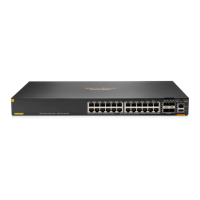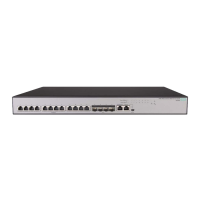4
Usage guidelines
A device can dynamically learn ARP entries. To prevent a device from holding too many ARP entries,
you can set the maximum number of dynamic ARP entries that the device can learn. When the
maximum number is reached, the device stops learning ARP entries.
When the number argument is set to 0, the device is disabled from learning dynamic ARP entries.
Examples
# Configure the device to learn a maximum of 64 dynamic ARP entries.
<Sysname> system-view
[Sysname] arp max-learning-number 64
arp mode uni
Use arp mode uni to configure a port as a customer-side port.
Use undo arp mode to restore the default.
Syntax
arp mode uni
undo arp mode
Default
A port operates as a network-side port.
Views
VLAN interface view
Virtual switch interface view
Predefined user roles
network-admin
Usage guidelines
By default, the device associates an ARP entry with routing information when the device learns an
ARP entry. The ARP entry provides the next hop information for routing. To save hardware resources,
you can use this command to specify a port that connects to a user terminal as a customer-side port.
The device will not associate the routing information with the learned ARP entries.
Examples
# Configure VLAN-interface 2 as a customer-side port.
<Sysname> system-view
[Sysname] interface vlan-interface 2
[Sysname-Vlan-interface2] arp mode uni
arp multiport
Use arp multiport to configure a multiport ARP entry.
Use undo arp to delete an ARP entry.
Syntax
arp multiport ip-address mac-address vlan-id [ vpn-instance vpn-instance-name ]
undo arp ip-address [ vpn-instance-name ]

